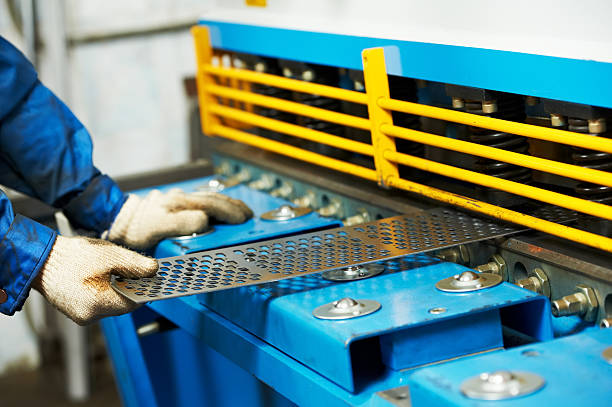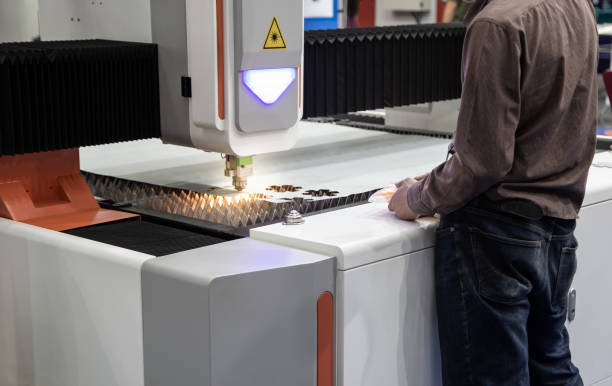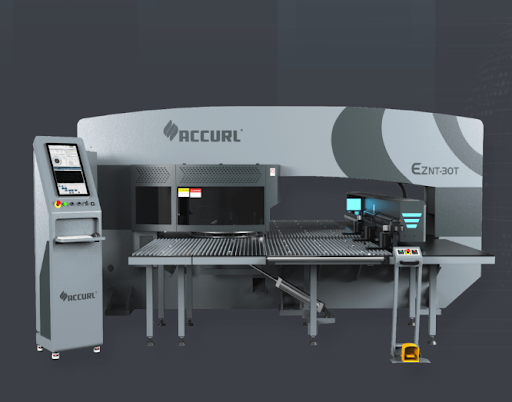In the realm of modern manufacturing, the adoption of cutting-edge technologies has revolutionized production processes, leading to increased efficiency, precision, and cost-effectiveness. Among these transformative innovations, punch cutting machines have emerged as indispensable tools across various industries.
From automotive to aerospace, and from electronics to packaging, punch cutting machines play a pivotal role in shaping raw materials into intricate components with unparalleled accuracy. This article delves into the profound impact of punch cutting machines on contemporary manufacturing, exploring their evolution, applications, benefits, and future prospects.
Understanding Punch Cutting Machines
Punch cutting machines, also known as punching machines or punch presses, are mechanical devices designed to cut or stamp flat sheet materials into desired shapes and sizes.
These machines operate through a simple yet effective mechanism: a punch, typically made of hardened steel, forcefully penetrates through the workpiece, while a die supports the material and ensures clean cuts.
Depending on the complexity of the task and the material involved, punch cutting machines can be equipped with various types of punches, dies, and auxiliary tools to achieve the desired results.
Evolution of Punch Cutting Technology
The origins of punch cutting machines can be traced back to the early days of industrialization, where rudimentary versions were employed for basic metalworking tasks. However, with advancements in engineering and materials science, punch cutting technology has undergone significant evolution over the years.
The integration of hydraulic, pneumatic, and, more recently, servo-electric systems has enhanced the speed, precision, and versatility of modern punch presses, enabling manufacturers to meet the demands of increasingly complex production requirements.
Components and Operation
A typical punch cutting machine comprises several key components, each contributing to its functionality and performance. These include:
- Punch and Die: The punch is the tool that exerts force to cut or shape the material, while the die provides support and defines the final form of the workpiece.
- Press Frame: The press frame provides the structural support for the machine, ensuring stability and rigidity during operation.
- Drive Mechanism: This component powers the movement of the punch and controls the force applied during cutting.
- Control System: Modern punch cutting machines are equipped with sophisticated control systems that regulate various parameters such as speed, pressure, and tool positioning, allowing for precise and repeatable operations.
Applications of Punch Cutting Machines
The versatility of punch cutting machines lends them to a wide range of applications across diverse industries. Some of the prominent sectors benefiting from the use of punch presses include:

Automotive Manufacturing
In the automotive industry, where precision and efficiency are paramount, punch cutting machines play a critical role in the fabrication of vehicle components.
From body panels and chassis parts to intricate interior fittings, punch presses are employed to cut, stamp, and form sheet metal with exceptional accuracy, contributing to the production of high-quality automobiles.
Electronics and Technology
In the realm of electronics manufacturing, where miniaturization and intricacy are driving forces, punch cutting machines enable the precise fabrication of circuit boards, enclosures, and other electronic components.
With the ability to handle various materials, including metals, plastics, and composites, punch presses facilitate the production of intricate parts essential for the functioning of modern electronic devices.
Packaging and Printing
The packaging industry relies heavily on punch cutting machines for the mass production of boxes, cartons, and packaging materials.
By efficiently cutting and scoring cardboard, paperboard, and corrugated materials, punch presses enable manufacturers to meet the diverse packaging needs of consumer goods, food products, pharmaceuticals, and more.
Additionally, in the printing industry, punch cutting machines are utilized for die-cutting and embossing operations, adding value and visual appeal to printed materials.
Aerospace and Defense
In aerospace and defense manufacturing, where stringent quality standards and tight tolerances are non-negotiable, punch cutting machines are indispensable for fabricating aircraft components, missile parts, and defense systems.
Whether it’s cutting aluminum alloys for aircraft structures or forming intricate shapes for missile guidance systems, punch presses play a vital role in ensuring the integrity and reliability of aerospace and defense applications.
Benefits of Punch Cutting Machines
The widespread adoption of punch cutting machines can be attributed to a myriad of benefits they offer to manufacturers. Some of the key advantages include:

Precision and Accuracy
Punch cutting machines excel in delivering precise and accurate cuts, ensuring consistency and quality in the manufactured components.
With advanced control systems and high-performance tooling, these machines can achieve tight tolerances and intricate geometries, meeting the most demanding specifications with ease.
High-Speed Production
Efficiency is a hallmark of punch cutting machines, allowing for rapid production cycles and increased output rates.
By automating the cutting process and optimizing tooling configurations, manufacturers can significantly reduce lead times and meet tight production schedules without compromising on quality.
Versatility and Flexibility
One of the standout features of punch cutting machines is their versatility across a wide range of materials and applications.
Whether it’s cutting sheet metal, plastics, rubber, or fabricating gaskets, seals, or decorative elements, punch presses offer unparalleled flexibility, making them ideal for diverse manufacturing environments.
Cost-Effectiveness
In addition to enhancing productivity, punch cutting machines contribute to cost savings through reduced material waste, lower labor costs, and minimized rework.
By optimizing material utilization and streamlining production workflows, manufacturers can improve their bottom line and remain competitive in today’s dynamic marketplace.
Future Trends and Innovations
As manufacturing technologies continue to evolve, the future of punch cutting machines looks promising, with several trends and innovations shaping the landscape:

Integration of Automation and Robotics
The integration of automation and robotics is poised to revolutionize punch cutting operations, enabling seamless integration with upstream and downstream processes.
By incorporating robotic loading and unloading systems, as well as in-line inspection and quality control mechanisms, manufacturers can achieve higher levels of efficiency, productivity, and process reliability.
Advancements in Tooling and Materials
Continued advancements in tooling materials and coatings are enhancing the performance and longevity of punch cutting tools. From carbide and high-speed steel to diamond-coated and ceramic tools, manufacturers have access to a diverse range of options to suit specific applications and materials.
Similarly, the development of lightweight and high-strength materials is expanding the capabilities of punch cutting machines, enabling the fabrication of complex components with improved durability and performance.
Adoption of Industry 4.0 Technologies
The advent of Industry 4.0 technologies, including IoT connectivity, data analytics, and predictive maintenance, is transforming punch cutting machines into smart manufacturing assets.
By leveraging real-time data and machine learning algorithms, manufacturers can optimize machine performance, anticipate maintenance needs, and enhance overall equipment effectiveness (OEE), leading to greater efficiency and profitability.
Conclusion
In conclusion, punch cutting machines have emerged as indispensable tools in modern manufacturing, revolutionizing production processes across a wide range of industries. With their precision, speed, versatility, and cost-effectiveness, these machines have become essential assets for manufacturers seeking to stay competitive in today’s dynamic market environment.
As technology continues to advance and new innovations emerge, the role of punch cutting machines is poised to expand further, driving efficiency, quality, and innovation in manufacturing for years to come.
